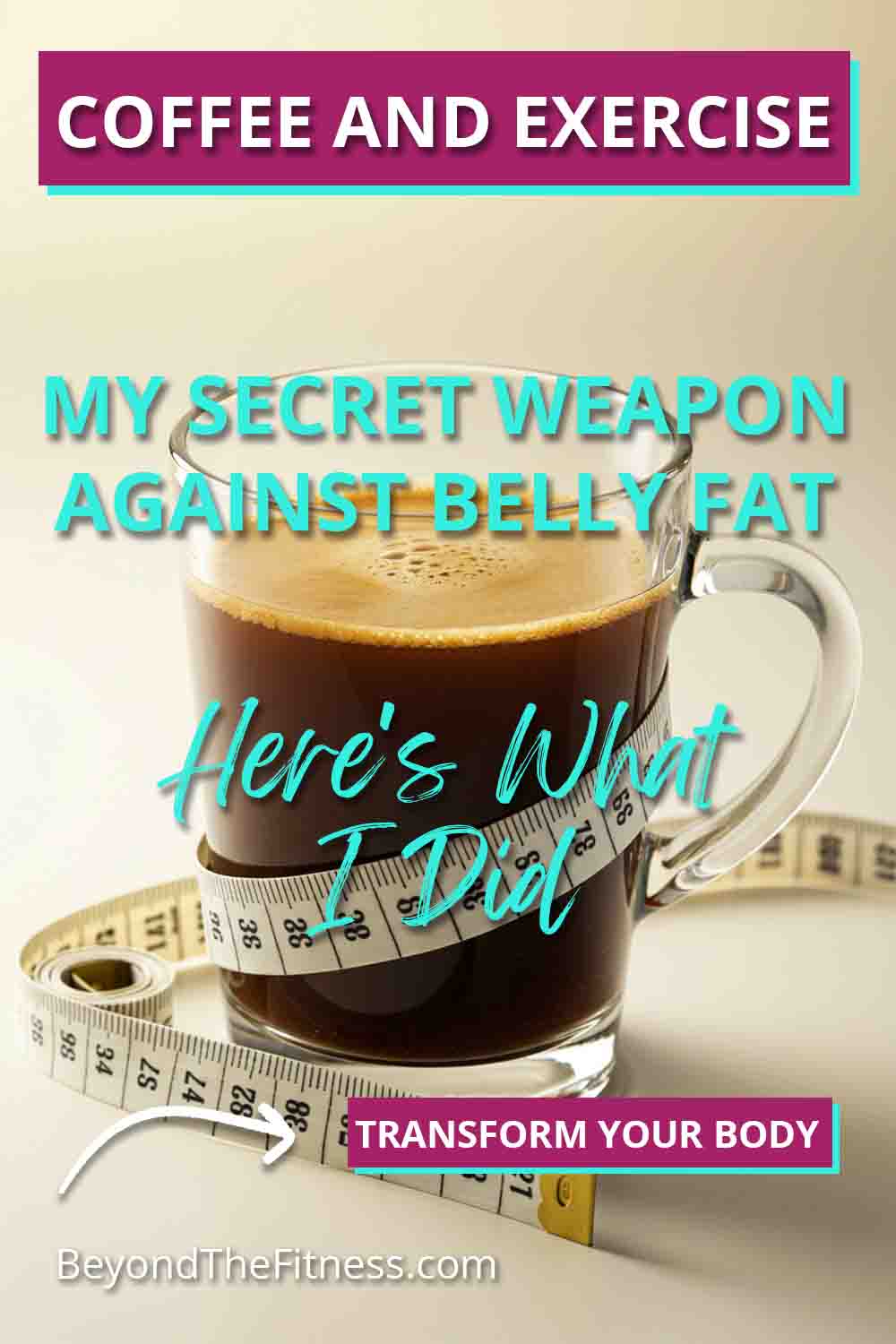It’s something many of us struggle with, that tricky fat that just seems to hang on no matter what we try. You know the areas I’m talking about, maybe it’s around the belly, the hips, or the thighs. We often call this “stubborn fat” because, well, it’s stubborn. It feels like the first place fat shows up and the very last place it leaves. Losing it can feel like a real uphill battle, especially for women, as our bodies sometimes like to hold onto fat in certain spots more than others.
But what if I told you there might be a simple combination that could give you an edge in this battle? Something many of us already enjoy daily? I’m talking about coffee paired with regular exercise. It might sound too simple, but there’s some interesting science behind why this duo could be particularly helpful for encouraging your body to let go of that resistant fat. Let’s dive into how this works and how you might use it to support your own health and fitness goals.
What Exactly Is Stubborn Fat?
Before we talk about how to lose it, let’s understand what makes some fat so stubborn. Is it really different from other fat? Not exactly. All fat cells are basically storage tanks for energy. When you eat more calories than your body needs right away, it stores the extra energy as fat for later use. When you need energy (like during exercise or if you haven’t eaten in a while), your body breaks down this stored fat and uses it as fuel.
So, why does some fat seem harder to lose? It often comes down to blood flow and the types of receptors on the fat cells in certain areas.
Think about it like this: some areas of your body have fat cells that are like locked vaults, while others have fat cells more like open piggy banks. The “stubborn” areas often have:
- Poorer Blood Flow: To burn fat, your body needs to send signals through the bloodstream to the fat cells, telling them to release their stored energy. Then, that released fat needs to travel through the bloodstream to where it can be burned (like your muscles). If an area has less blood flow, it’s harder for these signals and the released fat to get in and out efficiently. It’s like trying to make deliveries down a road with constant traffic jams.
- More Alpha-Receptors: Fat cells have different types of tiny “docking stations” called receptors. Think of them like light switches. Beta-receptors are like the “on” switch for fat burning – they respond to signals (like adrenaline) telling the cell to release fat. Alpha-receptors are more like the “off” switch – they tell the cell to hold onto its fat stores. Stubborn fat areas, particularly in women’s lower bodies (hips, thighs) and men’s lower abdominals, tend to have a higher concentration of these alpha-receptors compared to beta-receptors. This makes it harder to switch on the fat-releasing process in those specific spots.
So, stubborn fat isn’t a different type of fat, but it’s located in areas where the body has made it physiologically harder to access and burn that stored energy. This is often linked to genetics and hormones, which is why women tend to store fat differently than men. Our bodies are biologically designed to store energy efficiently, especially in areas important for childbearing, like the hips and thighs. While amazing from a survival standpoint, it can be frustrating when you’re trying to slim down.
Losing this fat usually means you need to lose overall body fat consistently over time. As your total body fat percentage drops, your body will eventually tap into these more resistant stores. There’s no magic way to only burn fat from your belly or thighs (spot reduction is largely a myth), but strategies that boost overall fat burning can help you finally see changes in those stubborn areas. And that’s where coffee and exercise come in.
How Coffee Can Lend a Helping Hand
Many of us start our day with coffee for that much-needed energy boost. But that jolt comes from caffeine, a natural substance that does more than just wake up your brain. Caffeine can actually interact with your body’s systems in ways that may encourage fat burning.
You Might Be Interested In: Enhancing Your Daily Coffee Ritual With Java Burn Weight Loss
Here’s how it works in simple terms:
- Stimulates the Nervous System: Caffeine gives your central nervous system a nudge. This causes nerve cells to fire more rapidly and triggers the release of hormones like adrenaline (also known as epinephrine). Adrenaline is famous for the “fight or flight” response, preparing your body for intense physical activity.
- Signals Fat Cells: Adrenaline travels through your bloodstream and reaches your fat cells. Remember those beta-receptors, the “on” switches for fat burning? Adrenaline binds to these receptors and sends a strong signal to the fat cells to start breaking down stored fat (a process called lipolysis).
- Releases Fatty Acids: When fat cells get this signal, they break down stored triglycerides (the main form of fat storage) into free fatty acids. These fatty acids are then released into the bloodstream.
- Provides Fuel: Once these fatty acids are floating around in your blood, they become available for your body, especially your muscles, to use as fuel. If you’re active, your body is more likely to grab these fatty acids and burn them for energy.
So, by drinking coffee, you’re essentially encouraging your body to unlock some of its stored fat and make it ready to be burned.
Coffee and Your Metabolism
You might have heard that coffee can “boost your metabolism.” Metabolism is basically the sum of all the chemical processes happening in your body to keep you alive, including converting food into energy. Caffeine can slightly increase your metabolic rate, meaning your body burns a few more calories even while at rest. This effect isn’t huge, but every little bit can add up over time when combined with other healthy habits. The main way coffee helps with fat burning, though, is through that process of mobilizing fat from your tissues.
Coffee for Better Workouts
Beyond directly influencing fat cells, coffee can also make your exercise sessions more effective. How?
- Increased Energy and Focus: That familiar caffeine buzz can make you feel more energetic and alert, helping you tackle your workout with more enthusiasm.
- Reduced Perception of Effort: Studies have shown that caffeine can make exercise feel easier. You might feel less tired or find you can push yourself a bit harder or longer than usual. This could mean burning more calories during your workout simply because you’re able to do more.
- Improved Performance: For certain types of exercise, particularly endurance activities like running or cycling, caffeine has been shown to improve performance. It might help you go faster or last longer.
By making exercise feel less daunting and potentially helping you perform better, coffee can be a great pre-workout companion.
When and How Much Coffee?
To potentially get the fat-burning and performance benefits for your workout, timing matters. Most experts suggest drinking coffee about 30 to 60 minutes before you start exercising. This gives the caffeine enough time to get into your bloodstream and start working its magic.
How much? You don’t need a huge amount. A standard cup of brewed coffee (about 8 ounces) typically contains around 95-165 milligrams of caffeine, depending on the beans and brewing method. Research suggests that doses around 3-6 milligrams of caffeine per kilogram of body weight (or about 1.4-2.7 mg per pound) are effective for performance benefits. For many people, one or two regular cups of coffee before a workout falls within this range.
It’s important to listen to your body, though. Some people are more sensitive to caffeine than others. Too much can lead to jitters, anxiety, stomach upset, or trouble sleeping. Start with a smaller amount (like one cup) and see how you feel.
Also, how you drink your coffee matters. Adding lots of sugar, cream, syrups, or whipped cream turns your potentially helpful pre-workout drink into a high-calorie sugar bomb. This can easily cancel out any fat-burning benefits. Stick to black coffee, or add just a splash of milk or a non-caloric sweetener if needed.
The Power of Exercise for Fat Loss
While coffee can help mobilize fat, exercise is what actually burns that fat. You need to create an energy demand so your body uses those fatty acids floating in your bloodstream as fuel. Without exercise or some form of calorie deficit, those released fatty acids might just get stored back in fat cells later.
Exercise is crucial for several reasons:
- Burns Calories: Physical activity directly burns calories. The more intense or longer the activity, the more calories you burn. This helps create the calorie deficit needed for overall fat loss.
- Uses Fat for Fuel: During moderate-intensity, longer-duration exercise (like jogging, cycling, or brisk walking), your body becomes quite efficient at using fat as a primary fuel source.
- Builds Muscle: Strength training (lifting weights, using resistance bands, bodyweight exercises) builds lean muscle mass. Muscle tissue is metabolically active, meaning it burns more calories at rest than fat tissue does. More muscle means a slightly higher resting metabolism, helping with fat loss over the long term.
- Improves Insulin Sensitivity: Exercise helps your body respond better to insulin, a hormone that manages blood sugar. Better insulin sensitivity is linked to better fat metabolism and can make it easier to lose fat, especially around the belly.
- Boosts Mood and Reduces Stress: Exercise releases endorphins, which can improve your mood and help combat stress. Since stress can sometimes contribute to fat storage (especially abdominal fat), managing it through exercise is beneficial.
What Kind of Exercise is Best?
The truth is, the best exercise routine is one you enjoy and can stick with consistently. However, a combination of different types of exercise is often most effective for overall fat loss and tackling stubborn areas.
- Cardiovascular Exercise (Cardio): This includes activities that get your heart rate up, like running, swimming, cycling, dancing, or using an elliptical machine.
- Steady-State Cardio: Exercising at a moderate, consistent pace for a longer duration (e.g., jogging for 30-60 minutes). This is great for burning fat during the workout itself.
- High-Intensity Interval Training (HIIT): Short bursts of very intense exercise followed by brief recovery periods (e.g., 30 seconds of sprinting followed by 60 seconds of walking, repeated several times). HIIT workouts are typically shorter but can burn a lot of calories quickly and may lead to a greater “afterburn” effect (EPOC – Excess Post-exercise Oxygen Consumption), where your body continues to burn extra calories for hours after the workout. HIIT might also be particularly good at stimulating the release of fat-burning hormones like adrenaline.
- Strength Training: Working your muscles against resistance is key.
- Builds Muscle: As mentioned, more muscle boosts your metabolism 24/7.
- Shapes Your Body: While you can’t spot-reduce fat, you can spot-build muscle. Developing muscle in areas like your glutes, legs, arms, and core can improve the shape and tone of those areas as you lose overall body fat. Stronger muscles also make everyday activities easier and help prevent injuries.
- Aim to work all major muscle groups 2-3 times per week, using weights, machines, resistance bands, or your own body weight (push-ups, squats, lunges).
A balanced routine might include 3-5 days of cardio (mixing steady-state and HIIT) and 2-3 days of strength training per week. Remember to include rest days to allow your body to recover and rebuild muscle.
The Winning Combo: Coffee Before Exercise
Now, let’s put it all together. Why is the combination of coffee before exercise potentially so effective, especially for that stubborn fat?
- Enhanced Fat Mobilization: Coffee, through caffeine, helps get those fatty acids out of the fat cells and into the bloodstream.
- Increased Fat Burning During Exercise: When you exercise after drinking coffee, your body has a greater supply of readily available fatty acids to use as fuel. Studies suggest that consuming caffeine before moderate-intensity exercise can significantly increase the rate at which your body burns fat during the workout. Your muscles are primed to grab those fatty acids mobilized by the caffeine.
- Improved Workout Performance: As we discussed, coffee can make you feel more energetic and reduce the feeling of effort. This might allow you to exercise a little longer or a little harder. A more intense or longer workout naturally burns more calories and potentially more fat.
- Targeting Stubborn Fat (Indirectly): Remember how stubborn fat areas often have poor blood flow and lots of those “off switch” alpha-receptors? Exercise increases overall blood flow, including potentially improving circulation to those stubborn areas over time. Caffeine also promotes the release of adrenaline, which primarily activates the “on switch” beta-receptors. While caffeine doesn’t magically switch off the alpha-receptors, the combination of increased adrenaline and the energy demand from exercise creates a stronger overall signal for fat release throughout the body. Over time, as you consistently burn more fat overall, your body will eventually have to tap into those more resistant stores. The coffee-exercise combo might just speed up that overall process.
Think of it like this: Coffee unlocks the vault (releases fatty acids), and exercise takes the money out and spends it (burns the fatty acids for energy). Doing both together makes the whole process more efficient.
Special Considerations for Women
While the coffee-exercise strategy can work well for many, women’s bodies have unique aspects to consider.
- Hormones: Female hormones, particularly estrogen, play a significant role in where fat is stored. Estrogen tends to encourage fat storage around the hips, thighs, and buttocks – those common “stubborn” areas for women. Hormonal fluctuations throughout the menstrual cycle, during pregnancy, or leading up to menopause can also affect metabolism, energy levels, and fat storage. This doesn’t mean fat loss is impossible, but it highlights why consistency and patience are key, and why strategies that optimize fat burning (like the coffee-exercise combo) can be helpful.
- Caffeine Sensitivity: Some women find they are more sensitive to caffeine’s effects, perhaps experiencing jitters, anxiety, or sleep disturbances more easily. Pay close attention to how your body reacts. If one cup of coffee makes you feel uncomfortably wired, try half a cup or switch to a lower-caffeine option like green tea (which also has some fat-burning properties, though less caffeine). Factors like hormonal shifts or certain medications can sometimes influence caffeine sensitivity too.
- Iron Levels: Women are more prone to iron deficiency, especially during their reproductive years. Iron is crucial for carrying oxygen to your muscles, and low levels can cause fatigue and hinder exercise performance. If you’re feeling constantly tired despite getting enough sleep, it’s worth getting your iron levels checked by a doctor, as no amount of caffeine can fix an underlying deficiency.
- Bone Health: Maintaining bone density is important for women, especially post-menopause. Weight-bearing exercise (like strength training, walking, jogging) is fantastic for bone health. While very high caffeine intake has sometimes been linked to calcium excretion, moderate consumption (like 1-2 cups of coffee) is generally not considered a major risk, especially if you have adequate calcium intake from your diet.
- Hydration: Both caffeine (which is a mild diuretic, meaning it makes you pee more) and exercise (through sweating) can lead to dehydration. Dehydration can hurt your workout performance and overall health. Make sure you’re drinking plenty of water throughout the day, especially before, during, and after your workouts, particularly if you’re having coffee beforehand.
Listening to your body is paramount. What works wonders for one person might not be ideal for another. Adjust your coffee intake and exercise routine based on how you feel.
Making It Work for You: Practical Steps
Ready to try combining coffee and exercise? Here’s a simple approach:
- Timing is Key: Drink 1 cup of plain black coffee (or with minimal additions) about 30-60 minutes before your planned workout.
- Choose Your Workout: Engage in exercise that you enjoy and that challenges you. A mix of cardio (like brisk walking, jogging, cycling, HIIT) and strength training throughout the week is ideal for overall fat loss and body composition changes.
- Focus on Consistency: Aim for regular workouts most days of the week. Fat loss, especially stubborn fat loss, is a marathon, not a sprint. Consistency is more important than occasional heroic efforts.
- Stay Hydrated: Drink water before, during, and after your exercise session. Don’t rely on coffee for hydration.
- Fuel Your Body Right: Coffee and exercise are tools, not magic wands. You still need a balanced, healthy diet to support fat loss. Focus on whole foods: lean proteins, plenty of vegetables and fruits, whole grains, and healthy fats. A moderate calorie deficit (burning slightly more calories than you eat) is generally needed for fat loss. Avoid crash diets, as they can slow your metabolism and are hard to sustain.
- Prioritize Sleep: Lack of sleep can mess with hormones that control appetite and fat storage (like ghrelin and leptin) and increase stress hormones like cortisol. Aim for 7-9 hours of quality sleep per night. Avoid caffeine too close to bedtime.
- Manage Stress: Chronic stress can also lead to increased cortisol levels, which can promote fat storage, particularly around the abdomen. Find healthy ways to manage stress, such as exercise itself, meditation, yoga, deep breathing, or spending time in nature.
- Be Patient: Stubborn fat is called stubborn for a reason. It will likely be the last fat to go. Don’t get discouraged if you don’t see changes in those specific areas right away. Focus on overall progress – feeling stronger, having more energy, clothes fitting better, and celebrating non-scale victories. Trust the process.
Combining coffee with exercise isn’t a shortcut, but it can be a smart strategy to enhance your body’s natural fat-burning processes and make your workouts feel more effective. By understanding how they work together and incorporating them wisely alongside a healthy lifestyle, you might just find the perfect pair to help you finally conquer that stubborn fat.
Related YouTube Video
Final Thoughts
Losing fat, especially the kind that seems determined to stick around, requires a thoughtful approach. It’s not just about doing one thing right, but about combining several effective strategies consistently. Using coffee strategically before your workouts could be one helpful piece of that puzzle. It taps into your body’s natural energy systems, potentially making fat more available to be burned and giving you a little extra boost to power through your exercise routine. Remember that everyone’s body is different, so paying attention to how you feel is important. Combine this potential boost with regular, enjoyable exercise, a nourishing diet, good sleep, and stress management, and you create a powerful foundation for achieving your health and fitness goals. Patience and consistency are your best friends on this journey.







